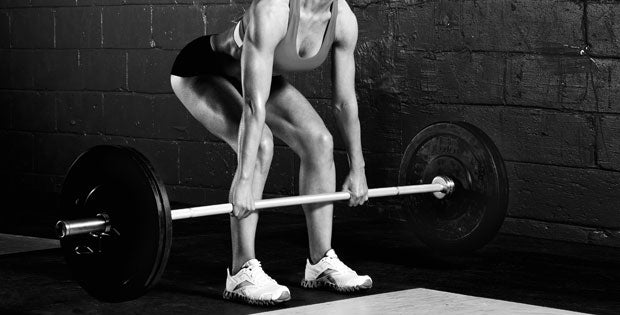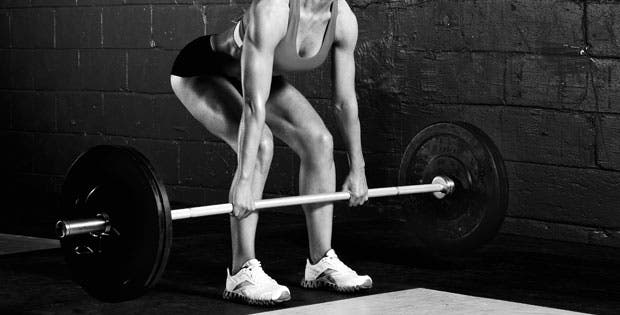The Big Three


Traditional powerlifting consists of the back squat, deadlift and bench press, a trio of exercises that works your entire body, front and back. And it isn’t just a sport for huge, grunting guys; women can transform their bodies by ripping hundreds of pounds off the floor, too. Because of its intensity, powerlifting increases your resting metabolic rate, even when workouts are short and sweet. Translation: more calories burned, even at rest, resulting in a leaner physique.
Powerlifting also engages more muscle fibers, not only because you use more muscle groups to perform the lifts but also because you lift heavier weights. This saves tons of time for busy trainees, further boosts metabolism and builds lean, fat-burning muscle. These compound movements also increase bone density and strengthen connective tissues, making you less susceptible to injury. Sound good? Of course it does. Try this routine on for size tomorrow and let’s take the power back from the boys!
The Plan
Because it’ll be very taxing, do your powerlifting routine on a separate day all its own. After a warm-up consisting of some light cardio and a few light sets of each exercise, choose a weight with which you’ll achieve failure at about 4–6 reps. (If you’re not sure where you’ll fail, try a weight you think will be heavy. If you can do more than six reps, it’s too light; if it’s crushing you at two reps, it’s too heavy.) If you’re new to powerlifting, do one set of each move to begin, then work your way up to three sets each.
| Exercise | Sets | Reps |
| Squat | 1–3 | 4–6 |
| Deadlift | 1–3 | 4–6 |
| Bench Press | 1–3 | 4–6 |
Squat

The only real difference between a powerlifting squat and a traditional one is depth: In powerlifting, your thighs break parallel.
Muscles used: Quads, glutes, abs, lower back, calves, hamstrings
Set-Up: Stand underneath a barbell in a rack and take an overhand grip on the bar. Unrack it and balance it across your upper back and shoulders, then take several large steps away so you’re clear of any obstacles. Stand with your feet hip-width apart and your toes turned out slightly.
Move: Kick your hips back and bend your knees, lowering your glutes toward the floor as you keep your weight in your heels. Continue to descend until the angle of your hips comes lower than your knees, then drive through your heels and extend your legs quickly to return to the start. Stop short of locking out your knees at the top.
Deadlift

Traditional and powerlifting deadlifts are the same in form and function, but shouldn’t be confused with Romanian deadlifts that don’t involve bending the knees.
Muscles used: Quads, glutes, hamstrings, total back, abs, shoulders, forearms
Set-Up: Place a loaded barbell on the floor. Step very close to the bar so it touches your shins and stand with your feet shoulder-width apart. Take an overhand grip, drop your hips low (but still above your knees) and lift your chest.
Move: Stand up, pushing through your heels while keeping your back flat, and drag the bar up along the front of your body. When your legs are fully extended, press your hips forward and pause before lowering back to the start.
Bench Press

A powerlifter typically spreads her feet very wide to create a greater base of stability. She also forms a significant arch in her back when lying on the bench to increase muscle tension and generate power with her core.
Muscles used: Chest, triceps, shoulders, core, glutes
Set-Up: Lie faceup on a flat bench with your feet spread wide, then pull your heels back several inches and arch your lower back off the bench, tightening your abs and pressing your shoulders firmly into the pad. Take a wider-than-shoulder-width grip on the bar and lift it off the rack, centering it over your chest across your nipple line.
Move: Lower the bar straight down until it nearly touches your chest, keeping your elbows pointing straight toward the floor. Explode back up by extending your arms quickly and pressing the bar straight toward the ceiling. Lock out briefly at the top.
Power Words
Even if you don’t want to compete in powerlifting, it’s good to know the jargon in case someone wants to chat about how much you bench. Here’s a quick primer on the most common competitive powerlifting terms and gear.
Hitting Parallel: When the tops of your thighs are parallel to the floor at the bottom of a squat. When competing, the squat doesn’t count unless the lifter hits parallel, but she isn’t required to go any lower than that.
No Lift: A failed lift attempt in competition.
Raw: Lifting without any supportive gear. Raw competitors are allowed to use a belt, wrist supports, chalk and powder.
Equipped: Lifting with supportive gear such as knee wraps or special clothing (bench press shirts and squat suits) that keep the muscles tight and stable.
Belt: Worn around the torso to create abdominal pressure to stabilize your core and support your spine during a lift.
Singlet: The standard powerlifting uniform. Not too flattering, but women wear a shirt underneath.
Chalk: Used on the hands to improve grip. Can also be applied to the back to prevent sliding on the bench.